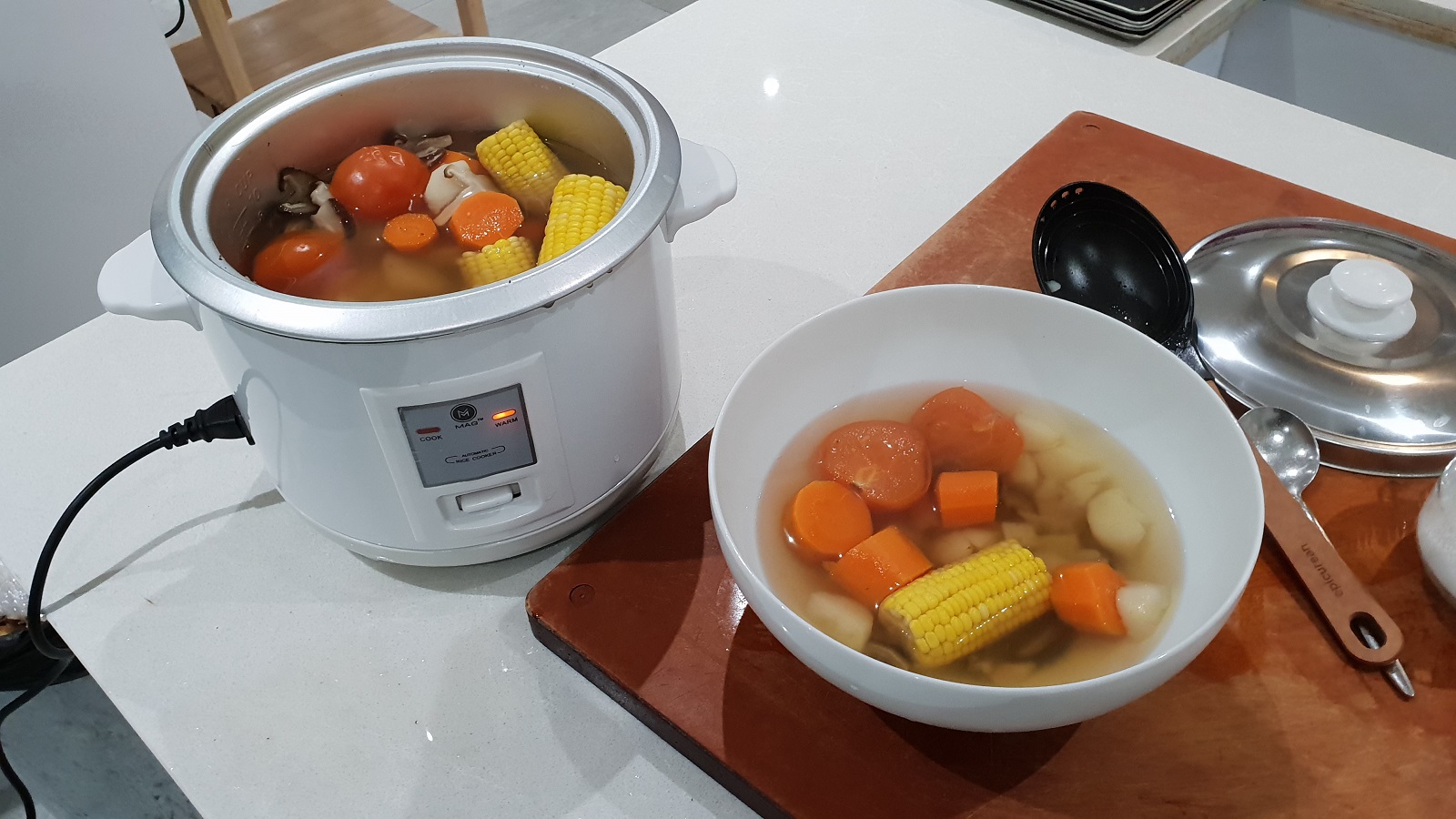

Articles
How To Store Miso Soup
Modified: December 7, 2023
Learn the best way to store miso soup and keep its freshness with these helpful articles. Find tips and tricks to preserve the flavors and nutrients in your homemade soup recipe.
(Many of the links in this article redirect to a specific reviewed product. Your purchase of these products through affiliate links helps to generate commission for Storables.com, at no extra cost. Learn more)
Introduction
Miso soup is a traditional Japanese dish that has gained popularity all around the world. It is a flavorful and nutritious soup made from fermented soybeans and other ingredients like seaweed, tofu, and vegetables. The rich umami taste and the comforting warmth of miso soup make it a favorite among many. Whether you enjoy it as a meal or as a part of a larger Japanese spread, storing miso soup properly is essential to maintain its freshness and flavor.
In this article, we will guide you on how to store miso soup effectively to prolong its shelf life and ensure that it maintains its taste and quality. From choosing the right container to reheating and even preserving homemade miso paste, we will cover all the necessary steps to keep your miso soup delicious and enjoyable.
So, let’s dive into the world of miso soup and learn the best practices for storage!
Key Takeaways:
- Properly storing miso soup is crucial for preserving its rich umami flavor and nutritional benefits. Choose the right container, refrigerate for a few days, or freeze for extended shelf life to enjoy this Japanese delicacy at your convenience.
- Homemade miso paste can be preserved in the refrigerator for months to a year, enhancing its flavor over time. Proper storage and periodic checks ensure you can savor the delightful umami goodness in your dishes whenever you desire.
Read more: How To Store Soup
Understanding Miso Soup
Miso soup is a staple in Japanese cuisine and is known for its complex yet balanced flavors. The key ingredient in miso soup is miso paste, which is made from fermented soybeans mixed with salt and koji, a type of fungus. The fermentation process gives miso its unique taste and aroma, as well as its health benefits.
There are different types of miso paste available, including white (shiro) miso, red (aka) miso, and mixed (awase) miso. Each type has its own distinct flavor profile, with white miso being milder and sweeter, and red miso being stronger and saltier. The choice of miso paste can vary depending on personal preference and the desired taste of the soup.
Aside from miso paste, miso soup typically contains other ingredients such as dashi (a broth made from dried bonito flakes or kombu seaweed), tofu, seaweed, and vegetables like green onions and mushrooms. These ingredients contribute to the depth of flavors and add texture to the soup.
Miso soup is not only delicious but also packed with nutritional benefits. It is rich in protein, vitamins, and minerals, and contains beneficial probiotics due to the fermentation process. It is also low in calories and fat, making it a great option for those following a healthy diet.
Now that we have an understanding of what miso soup is and its components, let’s move on to the proper storage methods to ensure its freshness and flavor.
Choosing the Right Container
When it comes to storing miso soup, choosing the right container is crucial to preserve its taste and quality. Here are a few factors to consider when selecting a container:
1. Material: Opt for containers made of glass or food-grade plastic. These materials are non-reactive and won’t affect the flavor or quality of the miso soup. Avoid using metal containers, as they can leave a metallic taste.
2. Airtightness: Make sure the container has a tight-sealing lid to prevent air from entering. Exposure to air can lead to oxidation and spoilage of the miso soup.
3. Size: Choose a container that can accommodate the desired amount of miso soup without leaving too much empty space. Excess airspace can promote spoilage, so it’s best to use a container that fits the quantity you intend to store.
4. Freezer-safe: If you plan to freeze the miso soup, ensure that the container is freezer-safe and can withstand low temperatures without cracking or breaking.
It’s worth noting that miso soup can stain containers made of certain materials, such as plastic. If you’re concerned about staining, consider using glass containers instead.
Once you have selected the right container, the next step is to properly store the miso soup. Whether you plan to store it in the refrigerator or freezer will depend on how long you intend to keep it.
Refrigerator Storage
To store miso soup in the refrigerator, follow these steps:
1. Allow it to cool: Let the miso soup cool down to room temperature before transferring it to the container. Hot soup can create condensation inside the container, leading to spoilage.
2. Transfer to airtight containers: Pour the cooled miso soup into clean, airtight containers. Make sure to leave some space at the top of the container to account for any expansion that may occur as the soup cools and freezes.
3. Label and date: It’s essential to label each container with the contents and the date it was stored. This way, you can keep track of how long the miso soup has been in the refrigerator and ensure you use it within a recommended timeframe.
4. Store in the refrigerator: Place the containers of miso soup in the refrigerator. Ideally, store them towards the back of the fridge, where it’s coldest and most consistent in temperature. Avoid placing them in the fridge door, as the temperature fluctuates more there.
5. Consume within a few days: Miso soup stored in the refrigerator should be consumed within 3-4 days for optimal freshness and flavor. After this time, the quality may start to decline, and there’s an increased risk of bacterial growth.
It’s important to note that miso soup may separate or the flavors may intensify slightly during storage. This is normal and can be easily remedied by giving the soup a gentle stir or shake before reheating and consuming.
Next, let’s explore the option of freezing miso soup to extend its shelf life.
Store miso soup in an airtight container in the refrigerator to maintain its freshness and flavor. It can last for up to a week when properly stored.
Freezing Miso Soup
If you have a surplus of miso soup or want to store it for a longer period, freezing is a great option. Here’s how to properly freeze miso soup:
1. Cool the soup: Allow the miso soup to cool down completely before freezing. This helps maintain the quality and prevents the formation of freezer burn.
2. Choose the container: Use freezer-safe containers or resealable freezer bags specifically designed for long-term storage. Squeeze out any excess air from the bags before sealing to minimize the risk of freezer burn.
3. Portion the soup: Divide the miso soup into individual or serving-sized portions. This way, you can easily thaw and reheat the desired amount without having to defrost the entire batch.
4. Label and date: Clearly label each container or bag with the contents and the date of freezing. This makes it easier to keep track of the storage time and ensure you use the oldest batch first.
5. Freeze flat: If using freezer bags, lay them flat on a baking sheet or similar surface before placing them in the freezer. This allows for easy stacking and saves freezer space.
6. Freeze quickly: Place the containers or bags in the coldest part of your freezer, preferably at the back. The faster the miso soup freezes, the better the quality will be once thawed.
7. Maximum storage time: Miso soup can generally be stored in the freezer for up to 3 months, but it’s best to consume it within 1-2 months for optimal taste and texture.
When you’re ready to enjoy the frozen miso soup, thaw it overnight in the refrigerator. Once thawed, reheat it gently on the stovetop, stirring occasionally to ensure even heating. Avoid microwaving the miso soup directly from frozen, as this can result in uneven heating and alter the flavor.
Now that you know how to freeze miso soup, let’s move on to reheating it to serve it piping hot.
Read more: How To Store Potato Soup
Reheating Miso Soup
When it comes to reheating miso soup, it’s important to do it gently to preserve its flavors and textures. Here are a few methods you can use to reheat miso soup:
1. Stovetop method: Transfer the desired amount of miso soup to a pot and heat it over low to medium heat. Stir occasionally to ensure even heating and prevent the soup from sticking to the bottom of the pot. Avoid boiling the soup, as it can cause the miso paste to break down and lose its flavors.
2. Microwave method: If you’re short on time, you can use a microwave to reheat miso soup. Place the soup in a microwave-safe bowl and heat it in short intervals, stirring in between, until it reaches the desired temperature. Be cautious not to overheat the soup, as the flavors can become diluted.
3. Double-boiler method: This method is perfect for heating miso soup without the risk of overheating or scorching. Fill a larger pot with hot water and place a smaller pot inside. Pour the miso soup into the smaller pot and heat it over medium heat. Stir occasionally until the soup reaches the desired temperature.
Regardless of the reheating method you choose, be mindful not to boil the miso soup vigorously, as it can harm the integrity of the miso paste and alter the flavor. Gentle and gradual heating will help maintain the flavors and textures.
Once the miso soup is heated, give it a gentle stir to redistribute any settled ingredients or flavors. You can garnish it with fresh herbs, chopped green onions, or a sprinkle of toasted sesame seeds to add an extra pop of flavor and visual appeal.
Now that you know how to reheat miso soup, let’s explore how to preserve homemade miso paste for future use.
Preserving Homemade Miso Paste
If you have made your own miso paste from scratch or have leftover homemade miso paste, you can store it to prolong its shelf life. Preserving homemade miso paste requires the right storage conditions to maintain its quality. Here’s how you can do it:
1. Allow fermentation: Homemade miso paste needs to undergo a fermentation process for optimal flavor development. Ensure that your miso paste has fermented for the required period of time, according to the recipe or your preferred taste. This will allow the flavors to mature and deepen.
2. Store in an airtight container: Transfer the miso paste into a clean, airtight container. Glass jars with tight-fitting lids work best for preserving miso paste. Make sure the container is clean and dry to prevent contamination.
3. Keep it refrigerated: Homemade miso paste should be stored in the refrigerator to maintain its freshness. The cooler temperature helps slow down the fermentation process and extend the shelf life of the miso paste.
4. Label and date: Remember to label the container with the type of miso paste and the date it was made. This will help you keep track of the age of the miso paste and ensure you use the oldest batch first.
5. Check periodically: Every few weeks, check on the miso paste to ensure there are no signs of mold or spoilage. If you notice any discoloration, off smells, or unusual textures, discard the miso paste as it may have gone bad.
6. Proper storage duration: Homemade miso paste can be stored in the refrigerator for several months to a year, depending on various factors such as the ingredients used and the fermentation process. It’s best to consume the miso paste within a year for optimal flavor.
Keep in mind that homemade miso paste will continue to ferment slowly in the refrigerator, which enhances its flavor. However, over time, the taste might become stronger and saltier. Adjust the amount of miso paste used in recipes accordingly.
By following these steps, you can enjoy the flavors and benefits of homemade miso paste for an extended period, adding depth and umami to your dishes whenever you desire.
With these methods, you can now store miso soup and homemade miso paste effectively, ensuring that their flavors and quality are preserved. Proper storage allows you to enjoy the delicious taste of miso soup at your convenience and make the most out of your homemade miso paste.
Miso soup is a versatile and comforting dish that brings a taste of Japan to your kitchen. Whether you’re enjoying it as a standalone meal or as part of a larger Japanese spread, proper storage ensures that you can savor its flavors and reap its nutritional benefits for a long time.
Now that you’re equipped with the knowledge of storing miso soup and miso paste, you can confidently prepare and preserve these delightful Japanese delicacies. So go ahead, make a warm bowl of miso soup and indulge in its umami goodness!
Conclusion
Miso soup is a beloved dish, cherished for its rich umami flavor and nutritional benefits. Knowing how to properly store miso soup is essential to preserve its taste, freshness, and quality. By following the right storage techniques, you can enjoy miso soup at your convenience and make the most out of homemade miso paste.
Choosing the right container is the first step in storing miso soup. Opt for glass or food-grade plastic containers that are airtight, ensuring they are freezer-safe if you plan to freeze the soup. Label each container with its contents and the date to keep track of storage times.
Refrigerator storage allows you to keep miso soup for a few days, while freezing extends its shelf life for several months. When reheating miso soup, do it gently to preserve the flavors and textures. Whether on the stovetop or in the microwave, avoid boiling the soup vigorously.
If you’ve made homemade miso paste, it can be preserved in the refrigerator for months to a year. Ensure it has undergone proper fermentation and store it in airtight containers. Check periodically for mold or spoilage, and adjust recipe quantities as the taste may intensify over time.
In conclusion, understanding how to store miso soup and preserve homemade miso paste allows you to enjoy the delightful flavors of this traditional Japanese dish. Whether you’re a miso soup enthusiast or just starting to explore its wonders, proper storage ensures that you can indulge in the comforting and nutritious goodness of miso soup whenever you desire.
So, next time you make a batch of miso soup, take the time to store it correctly. Whether in the refrigerator or freezer, in the right containers, or preserving homemade miso paste, these storage methods will help maintain the integrity of the miso soup, allowing you to relish its flavors for longer periods.
Now, it’s time to embark on a culinary journey and savor the umami delight of miso soup. From its flavorful broth to the nourishing ingredients, miso soup brings a taste of Japan to your table. So, get ready to warm your body and soul with a steaming bowl of miso soup!
Frequently Asked Questions about How To Store Miso Soup
Was this page helpful?
At Storables.com, we guarantee accurate and reliable information. Our content, validated by Expert Board Contributors, is crafted following stringent Editorial Policies. We're committed to providing you with well-researched, expert-backed insights for all your informational needs.















0 thoughts on “How To Store Miso Soup”